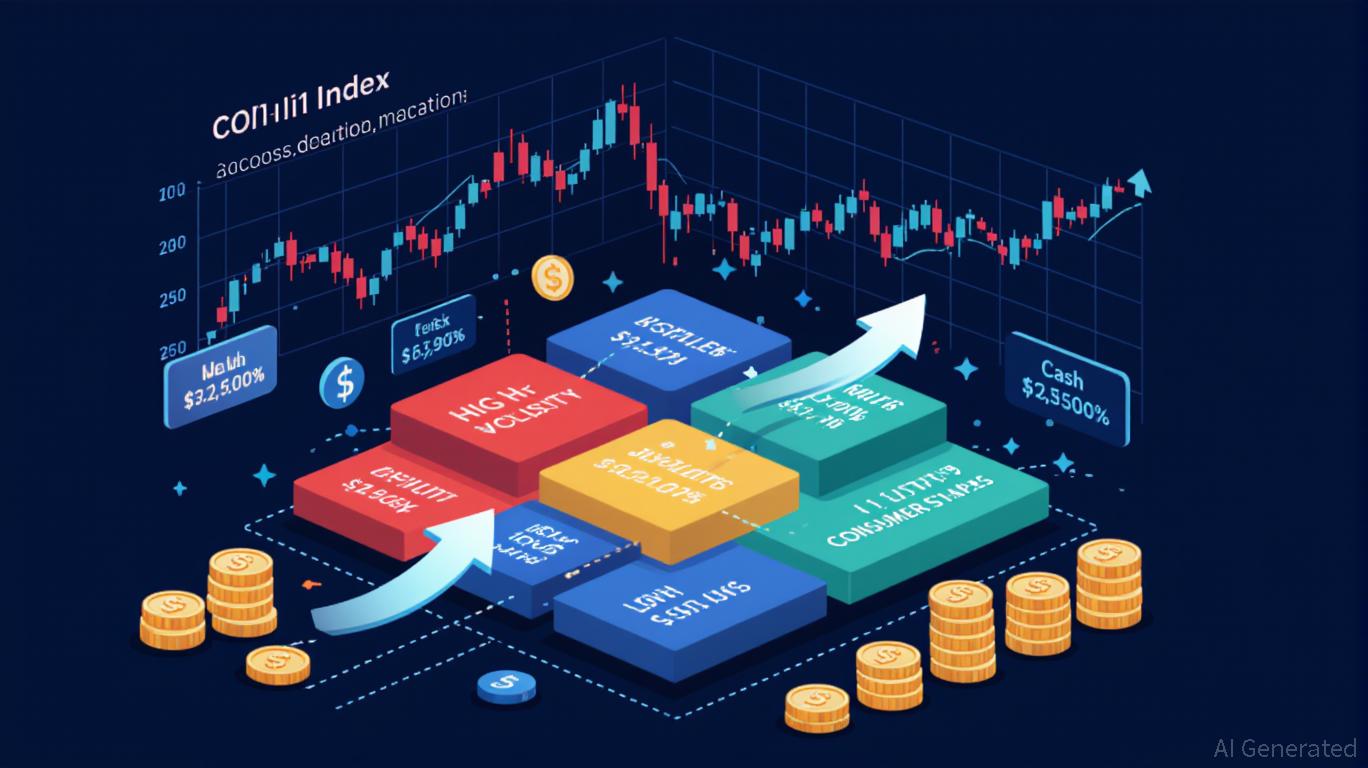The Unexpected COAI Price Decline: Key Lessons for Investors from the November 2025 Market Turbulence
- COAI Index's 88% November 2025 collapse stemmed from C3.ai governance failures, regulatory ambiguity, and panic-driven herd behavior. - Market psychology amplified losses as investors overreacted to AI sector risks, ignoring fundamentals and triggering liquidity crises. - Diversification, cash reserves, and AI-driven tools helped mitigate risks, emphasizing long-term strategies over speculative hype. - The crisis exposed dangers of overreliance on AI/DeFi narratives, urging disciplined, diversified portf
The COAI Index Crash: A Case Study in Market Fragility
In November 2025, the COAI Index experienced a dramatic decline, plummeting by 88% within a matter of weeks. This event starkly illustrated how quickly confidence can evaporate in speculative markets. The collapse was not just a routine correction; it was a systemic failure fueled by lapses in corporate governance, unclear regulatory guidance, and a wave of emotionally charged decisions by investors. This episode highlights the importance for investors to recognize the psychological dynamics at play during market upheavals and to employ disciplined, diversified approaches to safeguard their portfolios.
Key Triggers: Leadership Failures and Regulatory Confusion
The downfall of the COAI Index was set in motion by turmoil at C3.ai, a pivotal player in the AI and DeFi landscape. By early 2025, the company was already under pressure, having reported a $116.8 million deficit, undergone a contentious change in leadership, and faced a class-action lawsuit over alleged mismanagement. These issues severely undermined confidence in the company and, by extension, cast doubt on the broader promise of AI-powered crypto ventures. The situation was further complicated by the introduction of the CLARITY Act—a regulatory initiative intended to bring oversight to AI technologies. Instead of providing clarity, however, it left investors uncertain about compliance and potential liabilities, deepening the sense of instability.
Investor Behavior: Panic, Herd Mentality, and Biases
The crash of the COAI Index was as much about psychology as it was about economics. After months of volatility, investors responded with panic-driven selling, heavily influenced by herd behavior and cognitive distortions. According to a Bitget report, the market panic in April 2025, which was sparked by similar concerns in the AI sector, revealed that many investors fell prey to "recency bias"—overestimating the likelihood of ongoing gains while ignoring mounting risks. Social and traditional media amplified these anxieties, fueling a cycle of fear and further sell-offs. Deutsche Bank's AI-powered dbLumina system demonstrated that, during downturns, human investors often act irrationally, locking in losses and missing out on eventual recoveries.
This emotional response was evident as COAI investors continued to exit the market, even as the S&P 500 rebounded by 23% after the April 2025 low. Many mistook isolated corporate setbacks for systemic threats, triggering a liquidity crunch that intensified the decline.
Protective Measures: The Role of Diversification and Discipline

The COAI Index collapse underscored the necessity of robust risk management. Defensive tactics—such as shifting investments into traditionally stable sectors like utilities and consumer staples—became increasingly popular as investors sought to shield their capital. Fixed-income assets and cash holdings also served as important buffers against the volatility of the AI sector. Research from GetCOAI in 2025 found that maintaining a cash allocation of 20-30% enabled investors to seize opportunities in undervalued assets during the downturn.
For those with exposure to AI and DeFi, spreading investments across different regions and industries proved vital. Value and small-cap stocks, which often outperform during corrections in growth sectors, helped balance portfolios. Additionally, using options and derivatives—such as purchasing put options on broad market indices—offered protection against losses without sacrificing the potential for gains.
Long-Term Strategy: Steering Clear of Speculative Traps
The COAI Index crash also revealed the risks of chasing speculative trends. Many younger investors were drawn in by the promise of an "AI revolution," often at the expense of sound fundamentals. Those who maintained a long-term perspective and diversified their holdings weathered the storm more effectively. As highlighted by Investment News, investors who stuck to a balanced 60/40 mix of equities and fixed income experienced minimal capital loss during the crisis.
Importantly, the turmoil demonstrated the value of AI-based analytical tools in counteracting emotional decision-making. Systems like dbLumina, which assess market trends without human bias, provided more objective guidance during the downturn. This suggests that individual investors could benefit from incorporating algorithmic analysis into their investment strategies to help avoid panic-driven mistakes.
Takeaways: Building Resilience for Future Shocks
The events surrounding the COAI Index in November 2025 serve as a powerful lesson on the interconnected roles of governance, regulation, and investor psychology. While volatility is an inherent feature of speculative sectors like AI and DeFi, the scale of the collapse was magnified by herd behavior and insufficient risk management. The key message for investors is clear: diversify across sectors and asset types, maintain adequate liquidity, and focus on long-term fundamentals rather than short-lived trends. In a world where market disruptions are becoming more common, maintaining discipline and strategic foresight is essential for enduring success.
Disclaimer: The content of this article solely reflects the author's opinion and does not represent the platform in any capacity. This article is not intended to serve as a reference for making investment decisions.
You may also like
Shiba Inu’s Focus on Privacy Aims to Draw DeFi Interest Amid Price Challenges
- Shiba Inu (SHIB) stabilizes near $0.00000851, with traders monitoring $0.000008390 support and $0.000008840 resistance amid a descending channel pattern since early 2025. - A 1.7% weekly gain contrasts with a 17.4% drop from its 14-day high, while $132.8M trading volume highlights uncertainty despite a privacy-focused Shibarium upgrade integrating Zama's FHE technology. - Technical indicators show fragile equilibrium, with bearish EMAs and $380K net outflows reinforcing distribution trends, though analys

Bitcoin News Update: Greenidge Transitions to AI as Bitcoin Mining Faces Rising Expenses and Regulatory Challenges
- Greenidge Generation , a Bitcoin miner, shifts to AI/HPC amid industry cost and regulatory pressures. - Bitcoin mining profitability declines as hashrate hits 1.16 ZH/s and hash prices fall below $35. - Companies like Bitfarms abandon Bitcoin for AI/HPC, while CleanSpark reports $766M mining revenue surge. - Regulatory scrutiny intensifies over foreign mining hardware, with BlockQuarry promoting domestic alternatives. - Energy costs and debt disputes force Tether to halt Uruguayan mining, highlighting se

Bitcoin News Update: Institutions Favor Bitcoin's Reliability as Altcoin Growth Slows
- Bitcoin's market dominance exceeds 54%, driven by waning altcoin momentum and institutional preference for stability. - Altcoin Season Index at 23 signals Bitcoin-centric trends as macroeconomic pressures and regulatory uncertainty weaken alternative cryptocurrencies. - Institutional investors prioritize Bitcoin's scalability and infrastructure, exemplified by Bhutan's Ethereum integration and Bitcoin Munari's fixed-supply presale model. - Analysts highlight Bitcoin's role as a macroeconomic barometer, w
MMT Token TGE: Is This the Dawn of a New Era for Digital Asset Foundations?
- MMT Token's 2025 TGE secured $100M valuation from Coinbase Ventures, OKX, and Jump Crypto, with 1330% price surge post-launch. - Momentum DEX on Sui reported $13B trading volume and $320M TVL, leveraging CLMM architecture and cross-chain RWAs for institutional appeal. - 55% of hedge funds now hold digital assets, driven by U.S. CLARITY Act and EU MiCA 2.0, as MMT's RWA focus bridges traditional and blockchain finance. - Despite macroeconomic risks like 34.6% post-TGE volatility, MMT's governance model an
